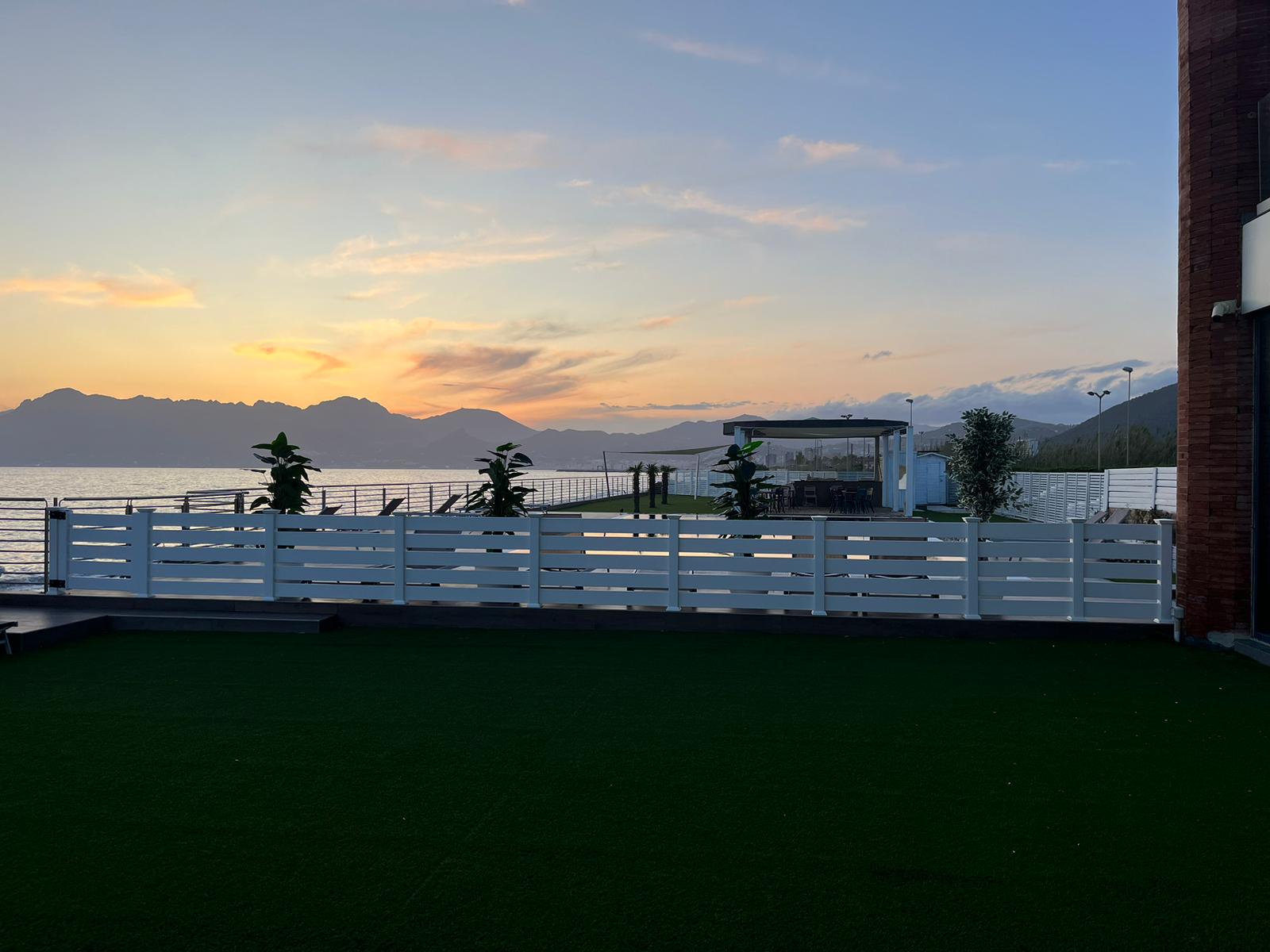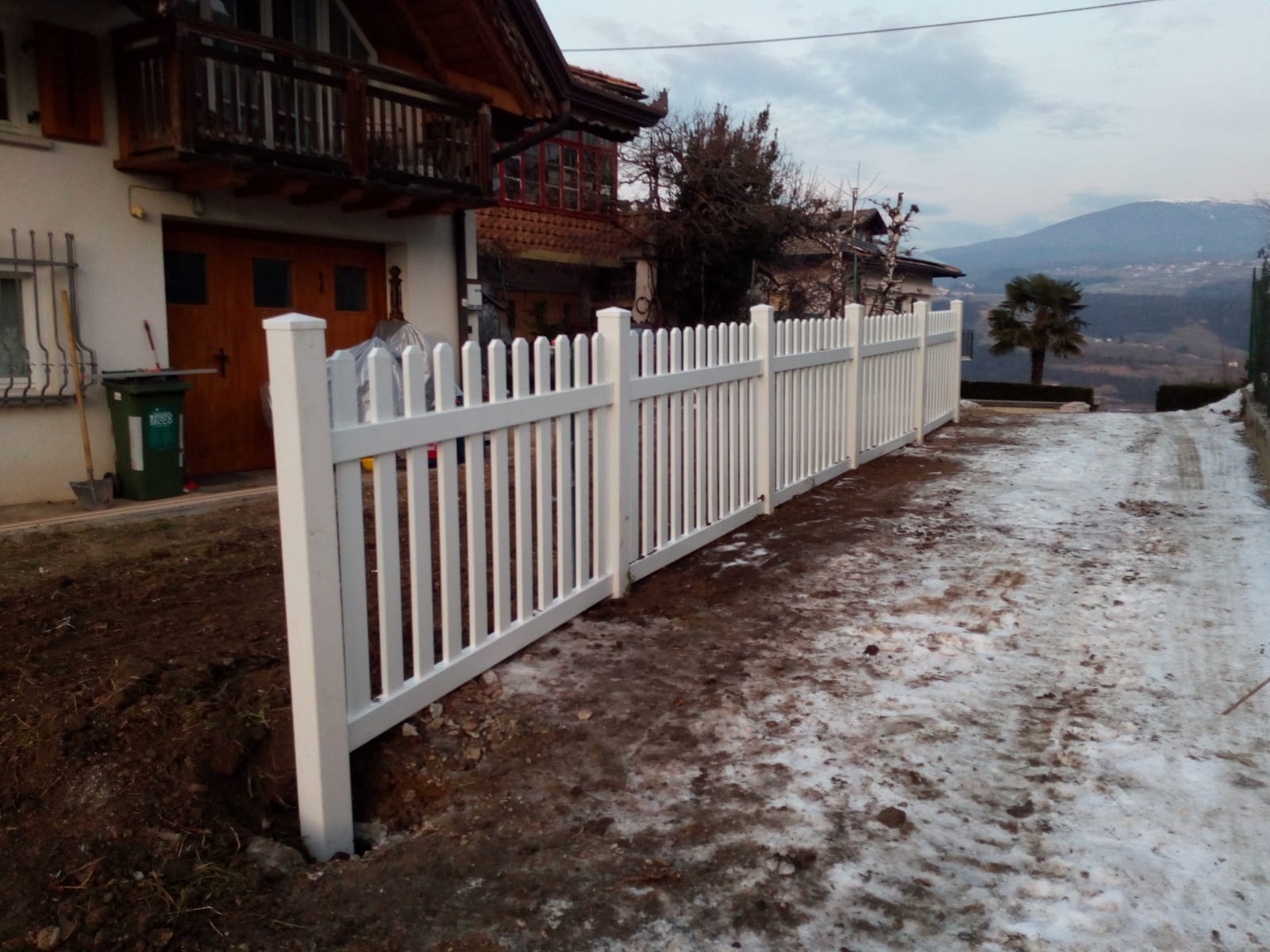Boundary strategies without rigid enclosures
How to protect your space without giving up the beauty of the sea
Imagine your establishment as a small open oasis, where the sea is felt from every corner and the gaze runs free toward the horizon. Now, imagine all this coexisting with your guests’ privacy, protection from the wind, and that light feeling of intimacy that turns any beach into a special place.
Yes, you can have all this without closing off the space with rigid, tall, and invasive walls. It only takes a bit of creativity, taste, and some good ideas.
Let’s see together how to do it.
Play with natural textures and elegant transparencies
When you think of a fence, don’t imagine it as a wall. Think instead of a functional design element that can tell a story and enhance every corner of your beach establishment. If you want to enclose without closing off, textures are your best allies.
One of the most appreciated solutions in boutique beach establishments is the use of woven reed screens, bamboo mats, or perforated wooden panels. These materials have a natural look, gently filter the light, and create that see-through effect that feels like a relaxing vacation. Above all, they don’t block the sea view—they frame it.
And you know what’s great? These textures easily adapt to even micro-spaces. You can use them to separate relaxation areas, define paths to showers or food zones, or simply create small shaded or reading spots.
The result is a defined environment, but without rigidity. Like a caress, not a shield.
Use the wind as an ally, not as an enemy.
The wind is part of life on the beach. Sure, it can be annoying sometimes, but if you learn to work with it, it can become a guiding element in your layout. No full closures, no barriers that trap sand: better to think of light and permeable fences.
An example? Nautical rope structures, stretched between wooden or metal posts, that define areas without blocking air circulation. They are aesthetically refined, easy to install, and blend perfectly with a modern or rustic marine style.
Or you can opt for micro-perforated outdoor fabrics mounted like vertical sails, which not only protect from the wind but also create a beautiful visual effect. And yes, you can also customize their colors to harmonize with your loungers, umbrellas, and your establishment’s branding.
To delimit doesn’t mean to close off: it means to guide the space, letting it breathe.
Use shade to suggest boundaries (without having to build them).
Here’s a trick that the nicest beach establishments know very well: shade is not just comfort, it’s also design. If you use shade sources the right way, you can create visual boundaries between different areas of your establishment without raising a single barrier.
Have you ever thought, for example, of using offset umbrellas to delimit the quieter areas? Or maybe a couple of low pergolas with light curtains, placed on the sides to create lounge corners? These elements, besides attracting the eye and making the environment more welcoming, suggest to your guests where a zone “begins” and “ends.” All this without saying a word, without raising walls, and without blocking the sea view.
Another simple but brilliant idea? Tall planters. Yes, those beautiful wooden boxes with Mediterranean plants that instantly create a chic atmosphere. Besides adding color and scent to the environment, they create real visual corridors, perfect for guiding flow between loungers and protecting certain areas from outside view.
Less barriers, more atmosphere: the secret lies in coherence.
Delimiting without closing off is an art, and like every art, it needs stylistic coherence. It’s not enough to place a reed here and a fabric there. If you want everything to work—and for your beach establishment to truly convey elegance and comfort—you need to take care of every detail.
Choose materials that tell your aesthetic vision. If your style is Mediterranean, focus on light wood, rope, and linen. If it’s more contemporary, maybe choose brushed steel, technical fabrics, and neutral colors. The important thing is that every element—even a simple boundary barrier—speaks the same language as the rest of your establishment.
The customer perceives it immediately: they enter, look around, and feel they are in a place designed with love. And at that moment, they’re not just renting a lounger. They’re living an experience.
The illusion of space: plays of transparency
Create lightness and depth in your beach establishment with smart details.
Have you ever noticed how some spaces seem bigger even though they’re actually very small? It’s not magic, it’s design. And in your boutique beach establishment, where every meter counts, knowing how to create the illusion of space can really make the difference between an “okay” environment and one that makes you say “wow.”
The good news is that you don’t need big investments or complex renovations. Often, just using transparent materials, light structures, and simple but clever visual tricks is enough to make the space breathe. And the feeling that results? More freedom, more comfort, and a much more elegant look.
The power of lightness: materials that let light through.
Let’s start with a simple truth: light is everything. The more a space is bright, the bigger it appears. And on the beach, light is never lacking. The trick is not to block it. That’s why, when you choose how to delimit or furnish your beach establishment, use materials that let light pass through.
Think of light nets, perforated fabrics, frosted glass, or even perforated metal panels. All these elements let you separate spaces without weighing them down. They are practical, beautiful, and above all, let air and light pass through, maintaining that sense of openness your customer looks for at the beach.
Want to create a small separate relaxation area? Use a natural linen fabric stretched over light structures. Want to give more privacy to VIP loungers? A low wooden fence with laser cuts or perforated patterns is the perfect solution.
The message you send is clear: this is a place to feel good, breathe, and enjoy the sea view even while having some privacy.
Visual transparencies: delimiting without breaking the view.
Your customer arrives, walks on the wooden path, looks around and… can see the sea even from afar. This is the kind of experience that creates an immediate emotional impact. Because an open view amplifies the perception of space.
How to achieve it? With fences that are visible but don’t impose. For example, frosted plexiglass panels are great for separating spaces without creating visual breaks. They resist salt air, are easy to clean, and blend well with the marine environment.
Or you can use wide-mesh wooden lattices, which let light and sight pass through but offer just enough filtering for privacy.
The arrangement of elements matters too. Avoid rigid, heavy alignments. Choose dynamic layouts, with small gaps and diagonal lines that guide the eye. That way, even if your beach establishment has only 30 umbrellas, it will feel as spacious as one with 100.
And don’t forget color. Sand tones, warm white, or natural wood reflect light and lighten the environment. Avoid dark, solid colors that close off the space, especially if used in large amounts.
Reflections and depth: the optical illusion that captivates.
Want an interior designer’s trick? Reflections multiply space. And you don’t have to put a mirror on the beach, but you can use glossy surfaces, glass, semi-transparent panels, or even metallic decorative elements to create a sense of depth.
An example? A side wall with glossy inserts or a decorative sail with shiny fabric inserts. The reflection of the sun amplifies brightness and gives a very refined optical effect. If you place these elements near walkways or common areas, you’ll get a space that feels wider, open, and airy.
Vegetation can help too. Tall, slender plants like bamboo or grasses create movement and depth. When they sway in the wind, they add dynamism to the space.
And between one bush and another, a small visual opening gives the idea of a space that continues beyond. It’s an invitation to explore, to feel part of a place designed down to the smallest detail.
Transparency is a choice of style (and hospitality).
Delimiting with lightness is not just an aesthetic matter. It’s a choice that communicates openness, elegance, and care for the customer’s well-being.
Your beach establishment is not just a simple beach. It’s a place where people relax, breathe, and feel free. And all this also comes from what is unseen, or rather, from what is allowed to be seen.
With the right materials, smart combinations, and a touch of creativity, you can transform a small space into a great experience. A boutique corner where every detail speaks of comfort, elegance, and freedom.
So go ahead with plays of transparency. Because in lightness, there’s much more space than you think.
Visual and real comfort: well-protected relaxation areas.
When the space embraces you, the customer relaxes.
At the beach, true luxury is feeling safe… without feeling confined. Your beach isn’t just sand and loungers: it’s a temporary refuge, a place where every detail should say “relax, we’ve got you covered.”
That’s why creating well-protected relaxation areas, both visually and physically, makes all the difference. Your guests want to feel comfortable, pampered, and safe, without losing the visual connection to the sea.
In this article, you’ll discover how to offer real and perceived comfort through small design and layout adjustments that transform your establishment’s experience.
Separate without isolating: the trick to make them feel free and calm.
One of the most common mistakes is thinking that “protection” means “closure.” In reality, people relax more when they feel free, but with a reassuring sense of enclosure.
For example, instead of installing solid dividers between umbrella rows, you can use light, perforated, or semi-transparent panels that provide a soft visual barrier, perfect for ensuring some privacy without taking away the pleasure of watching the sea or the sky.
Alternatively, try creating micro relaxation zones with loungers slightly separated by planters, light curtains, or wide-mesh wooden structures. That way, each guest feels like they have “their space” but doesn’t feel isolated from the rest of the beach.
It’s a visual trick that works very well because it stimulates that feeling of psychological comfort without sacrificing the beauty of the landscape.
Natural barriers and warm materials: comfort for the eyes too.
Comfort is not just physical; it’s also visual. An environment made of natural materials, soft shapes, and relaxing colors creates well-being at first sight. And yes, the brain perceives it immediately: if the space is harmonious, the mind relaxes.
That’s why delimiting relaxation areas with Mediterranean plants, bamboo mats, linen curtains, or nautical ropes can work wonders. These materials not only protect from wind or outside views but also convey a sense of calm and authenticity.
You can alternate small tall planters with aromatic herbs (lavender, rosemary, santolina) with natural wooden structures that separate paths from relaxation areas. And if you want an extra touch, add soft lights or lanterns to make the atmosphere even cozier at sunset.
The message you communicate is clear: this is not just a place to sunbathe, it’s a place to feel good.
Climatic comfort: protection from wind and sun, with style.
Sun and sea are wonderful, but without some protection they become… demanding. Your client seeks thermal comfort and wind protection, especially if they come to the beach with children, elderly people, or simply to truly relax.
That’s why it’s essential to offer solutions that ensure a pleasant microclimate without sacrificing aesthetics and lightness.
Low perforated wooden fences, micro-perforated technical fabric barriers, or angled sunshades are great tools to block the most annoying drafts and provide pleasant shade.
When positioned correctly according to sun and wind exposure, these elements can radically change the perception of the space.
And if you really want to impress, you can create small open lounge cabins, furnished with light curtains and cushions, for a fully comfortable experience. They’re not just beautiful to look at — they’re irresistible to live in.
The detail that matters: a relaxation area to remember
Creating well-protected relaxation areas means paying attention to detail without ever losing lightness. It takes little to transform a row of loungers into an exclusive area: a natural fabric screen, a well-placed planter, a cloth gently swaying in the sea breeze.
Your goal is not just to “provide shade” or “protect from the wind.” It’s to create an emotional space, a corner where your client feels welcomed, protected, and in harmony with the environment.
And when you succeed, something beautiful happens: people want to come back. Because they don’t just remember the sea — they remember how they felt on your beach.
Creative micro-enclosures for kids’ or lounge areas
Small well-defined spaces, maximum comfort for everyone
Your beach club is a place where every detail matters. Even a small relaxation area, if well designed, can become one of the highlights of the experience you offer your guests.
And when it comes to kids’ or lounge areas, there’s one key concept: well-protected micro-spaces, but with style.
You don’t need to build walls or install heavy structures. Lightweight, movable, and well-designed fences are enough to shape different functions: play, relaxation, privacy. All harmoniously integrated with the aesthetics of your beach.
Discover how to do it with practical, elegant, and unobtrusive ideas.
Kids’ areas: light protection and space for imagination
Kids always have fun at the beach. But parents? They often desperately look for a corner where little ones can play safely without having to watch them every five seconds.
And that’s where you come in.
You can create a kids’ micro-area enclosed by a small light wood fence, nautical ropes, or colorful mesh panels. It doesn’t need to be a cage, but a visual boundary that says “this is the place to have safe fun.”
The most popular solutions?
-
Low wooden posts with knotted rope, easy to move and super aesthetic.
-
Planters arranged in a circle, with some Mediterranean grasses and nature-themed toys.
-
Rubber or jute mats, bordered by small bamboo or colored PVC boundaries.
You can add some light curtains, a couple of wooden toys, and voilà: you have a safe, cheerful, and photogenic space.
This way, even the parents relax. And if the parents relax, the beach club works better for everyone.
Dream lounge: privacy and comfort in just a few square meters
Now let’s talk about the other side of relaxation: adults. For them, the dream is to have a chill zone with shade, tranquility, and a bit of style. And here too, a micro-enclosure can completely change the perception of the space.
We’re not talking about creating rigid fences, but visually delimiting a small lounge area with:
-
Light curtains hung on wooden structures, perhaps on a square or hexagonal base.
-
Movable metal or wooden lattices, decorated with artificial climbers or translucent fabrics.
-
Tall planters alternating with low seats to create a beach “lounge” effect.
Inside you can put two armchairs, a small table, and some outdoor cushions.
If you want to make a great impression, add solar lamps for sunset hours or some scented candles in the evening.
Even with just 3 by 3 meters, you can offer a premium space that stands out without impacting the surrounding environment.
Creativity + modularity = spaces that adapt to you
The beauty of creative micro-enclosures is that they’re not permanent. You can move, modify, expand, or reduce them according to the needs of the day or season.
Think of modular fences in wood and rope that connect like a puzzle. Or folding screens in technical fabric that you can reposition in minutes.
Metal tube structures with sliding curtains are also perfect for creating dynamic and adaptable environments.
During events, aperitifs, or low-traffic days, you can easily transform a lounge area into a small reading corner, a yoga nook, or even a space dedicated to baby parking.
In this way, your facility becomes flexible, welcoming, and ready to impress even the most demanding customer.
And if you add a touch of visual storytelling — maybe with wooden signs, embroidered cushions, or marine-style decorations — the micro-enclosure becomes a place with identity, not just a space.
Conclusion: small spaces, big impact
In the world of boutique facilities, every detail is an opportunity to offer a more refined, more personal, more memorable experience.
Creative micro-enclosures for kids’ areas or lounges allow you to shape important functions without cluttering, breaking the aesthetics, or sacrificing the overall harmony of the space.
With few elements — but carefully chosen — you can protect, pamper, and surprise, making every guest feel part of something special.
Because in the end, the true luxury on the beach is this: a small space designed just for you.







Leave A Comment